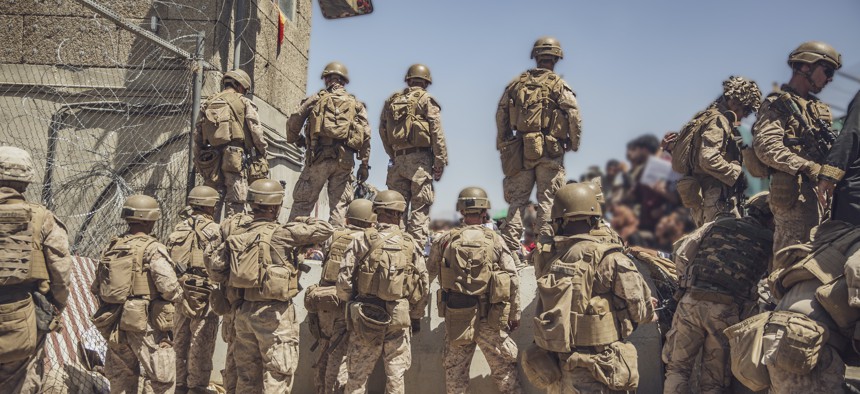
U.S. Marines assist with security at an Evacuation Control Checkpoint at Hamid Karzai International Airport, Kabul, Afghanistan, Aug. 26, 2021. U.S. Marine Corps / Staff Sgt. Victor Mancilla
The Final Retrograde from Afghanistan Has Officially Begun
The threat to U.S. personnel, aircraft in the final days at Kabul airport remains “very real” after a retaliatory U.S. drone strike took out two ISIS-K planners.
The U.S. military has begun the process of withdrawing from Hamid Karzai International Airport but pledged to continue to evacuate people despite threats to the dwindling force and its outbound aircraft, the Pentagon said Saturday.
Late on Friday, the U.S. conducted a drone strike against an ISIS location in Nangahar province, Pentagon officials said, in retaliation for the group’s suicide bombing that killed 13 service members and as many as 170 Afghans just outside the airport’s Abbey Gate.
The Joint Staff deputy director for regional operations, Army Maj. Gen. William "Hank" Taylor, said on Saturday that the strike killed two “high-profile” members of ISIS-K, a facilitator and a planner.
Still, Taylor and Pentagon press secretary John Kirby said, that the threats against the remaining U.S. personnel on the ground in Kabul remain “very real.”
“We are monitoring them literally in real time,” Kirby said. “We're taking all the means necessary to make sure we remain focused on that threat stream.”
With limited flights and hours on the ground left before the Aug. 31 deadline for full withdrawal, the military has begun destroying some of its larger items that commanders on the ground have determined they don’t want to fly out, but don’t want to fall into enemy hands. This will make as much room as necessary for people and critical equipment on those last planes out.
“We have begun retrograding,” Kirby said, using the military term for the removal of equipment and forces as a military operation ends.
U.S. passport holders are still being allowed through the airport gates, but it has become much more difficult for SIV applicants—that is, Afghans who have helped U.S. forces and have applied for Special Immigrant Visas to the United States. Taliban fighters are going door to door, raiding the houses of Afghans who worked with the U.S. Many families who have not been able to get to the airport, through security, and onto an evacuation plane have gone into hiding.
Kirby said the military will still fly out SIV applicants and will continue to do so until the final plane departs.
“Nothing has changed about the timeline for us,” said Pentagon press secretary John Kirby. “That includes being able to continue to evacuate right up until the end.”
To date, U.S. and coalition aircraft have flown out more than 117,000 evacuees, most of them Afghan citizens.







